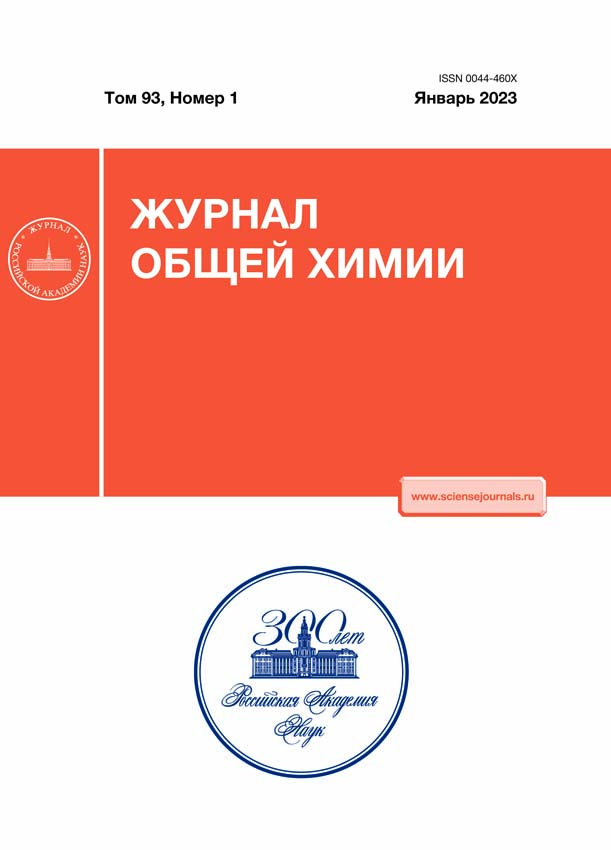Photochemical production of molecular hydrogen in the presence of substituted acridine salts
- Authors: Dolganov A.V1, Klimaeva L.A1, Okina E.V1, Knyazev A.V2
-
Affiliations:
- N.P. Ogarev National Research Mordovia State University
- Lobachevsky State University
- Issue: Vol 93, No 1 (2023)
- Pages: 77-83
- Section: Articles
- URL: https://rjmseer.com/0044-460X/article/view/667124
- DOI: https://doi.org/10.31857/S0044460X23010092
- EDN: https://elibrary.ru/OZLORD
- ID: 667124
Cite item
Abstract
The photocatalytic properties of new representatives of the family of metal-free catalysts, 10-hydro-9-phenylacridine, 10-methyl-9-phenylacridinium chloride, and 10-phenyl-9-phenylacridinium chloride, were studied with respect to the reaction of molecular hydrogen generation in the presence of acids of different strength (HClO4, CH3SO3H, and CF3COOH) and reducing agents ([Bu4N]Cl, [Bu4N]Br, and [Bu4N]I). It was found that the strength of acids (p K a) and the nature of the reducing agent ( E 0) significantly affect the efficiency, i.e. turnover frequency (TOF), of the process under study. The amount of formed molecular hydrogen reaches its maximum in the case of the combination HClO4 and [Bu4N]I, characterized by minimal p K a and E0 values, respectively. The influence of the nature of substituents at the nitrogen atom in 9-phenylacridine on the efficiency of the molecular hydrogen production was analyzed. It was shown that the limiting stage of the process is the protonation of the formed radical.
About the authors
A. V Dolganov
N.P. Ogarev National Research Mordovia State University
Email: dolganov_sasha@mail.ru
L. A Klimaeva
N.P. Ogarev National Research Mordovia State University
E. V Okina
N.P. Ogarev National Research Mordovia State University
A. V Knyazev
Lobachevsky State University
References
- Spasiano D., Marotta R., Malato S., Fernandez P.I., Somma D. // Appl. Catal. (B). 2015. Vol. 170-171. P. 90. doi: 10.1016/j.apcatb.2014.12.050
- Goff A.L., Artero V., Jousselme B., Tran P.D., Guillet N., Métayé R., Fihri A., Palacin S., Fontecave M. // Science. 2009. Vol. 326. P. 1384. doi: 10.1126/science.1179773
- Lazarides T. // J. Am. Chem. Soc. 2009. Vol. 131. P. 9192. doi: 10.1021/ja903044n
- Esswein A.J., Nocera D.G. // Chem. Rev. 2007. Vol. 107. N 10. P. 4022. doi: 10.1021/cr050193e
- Krishnan C.V., Sutin N. // J. Am. Chem. Soc. 1981. Vol. 103. P. 2141. doi: 10.1021/ja00398a066
- Krishnan C.V., Brunschwig B.S., Creutz C., Sutin N. // J. Am. Chem. Soc. 1985. Vol. 107. P. 2005. doi: 10.1021/ja00293a035
- Lei J.-M., Luo S.-P., Zhan S.-Z. // Polyhedron. 2018. Vol. 154. P. 295. doi: 10.1016/j.poly.2018.07.040
- Gueret R., Poulard L., Oshinowo M., Chauvin J., Dahmane M., Dupeyre G., Lainé P.P., Fortage J., Collomb M.-N. // ACS Catal. 2018. Vol. 8. P. 3792. doi: 10.1021/acscatal.7b04000
- Takizawa S., Pérez-Bolívar C., Anzenbacher P.Jr., Murata S. // Eur. J. Inorg. Chem. 2012. Vol. 2012. P. 3975. doi: 10.1002/ejic.201200474
- Yu Z.-T., Yuan Y.-J., Cai J.-G., Zou Z.-G. // Chem. Eur. J. 2013. Vol. 19. P. 1303. doi: 10.1002/chem.201203029
- Yuan Y.-J., Yu Z.-T., Gao H.-L., Zou Z.-G., Zheng C., Huang W. // Chem. Eur. J. 2013. Vol. 19. P. 6340. doi: 10.1002/chem.201300146
- Wang X.-B., Zheng H.-Q., Rao H., Yao H.-C., Fan Y.-T., Hou H.-W. // Appl. Organometal. Chem. 2016. Vol. 30. P. 638. doi: 10.1002/aoc.3481
- Wang J., Li C., Zhou Q., Wang W., Hou Y., Zhang B., Wang X. // Dalton Trans. 2016. Vol. 45. P. 5439. doi: 10.1039/C5DT04628A
- Helm M.L., Stewart M.P., Bullock R.M., DuBois M.R., DuBois D. // Science. 2011. Vol. 333. P. 863. doi: 10.1126/science.1205864
- Mazzeo A., Santalla S., Gaviglio C., Doctorovich F., Pellegrino J. // J. Inorg. Chim. Acta. 2020. Vol. 517. P. 119950. doi: 10.1016/j.ica.2020.119950
- Selvamani T., Anandan S., Ashokkumar M. In: Micro and Nano Technologies. Nanoscale Graphitic Carbon Nitride. Elsevier, 2022. P. 17. doi: 10.1016/B978-0-12-823034-3.00002-9
- Romero N.A., Nicewicz D.A. // Chem. Rev. 2016. Vol. 116. P. 9629. doi: 10.1021/acs.chemrev.6b00057
- Fukuzumi S., Lee Y.-M., Nam W. // Springer Handbook of Inorganic Photochemistry. 2022. P. 1385. doi: 10.1007/978-3-030-63713-2_46
- Dolganov A.V., Tanaseichuk B.S., Moiseeva D.N., Yurova V.Y., Sakanyan J.R., Schmelkova N.S., Lobanov V.V. // Electrochem. Commun. 2016. Vol. 68. P. 59. doi: 10.1016/j.elecom.2016.04.015
- Долганов А.В., Баландина A.В., Чугунов Д.Б., Тимонина А.С., Люкшина Ю.И., Ахматова А.А., Юдина А.Д., Шиндина В.В., Жирнова В.О., Климаева Л.А., Осипов А.К. // ЖОХ. 2020. Т. 90. Вып. 7. С. 1040
- Dolganov A.V., Balandina A.V., Chugunov D.B., Timonina A.S., Lyukshina Yu.I., Akhmatova A.A., Yudina A.D., Shindina V.V., Zhirnova V.O., Klimaeva L.A., Osipov A.K. // Russ. J. Gen. Chem. 2020. Vol. 90. N 7. P. 1229. doi: 10.1134/s1070363220070099
- Kotani H., Ono T., Ohkubo K., Fukuzumi S. // Phys. Chem. Chem. Phys. 2007. Vol. 9. P. 1487. doi: 10.1039/b612794k
Supplementary files










